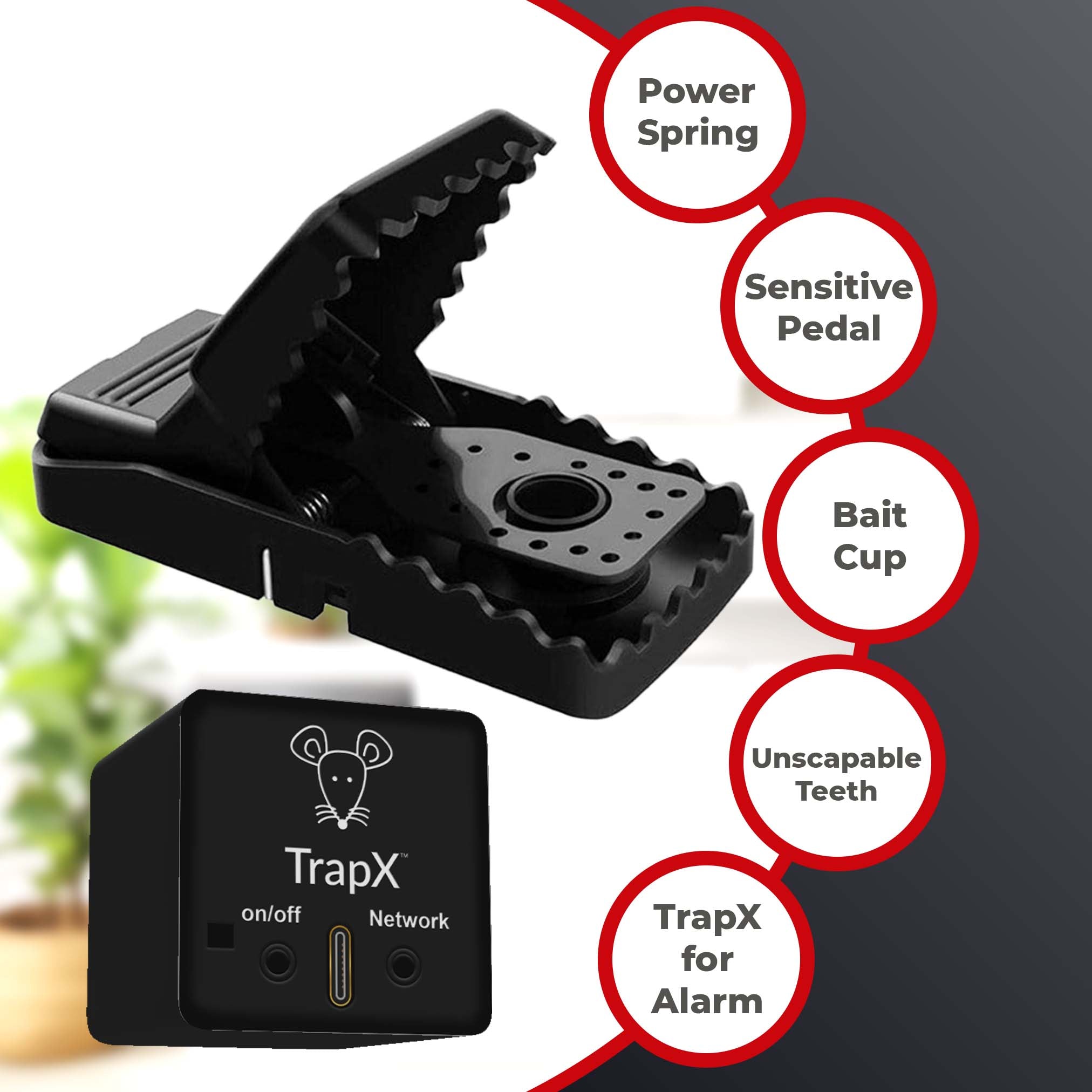The Future of Rodent Control: Exploring the Wireless Mouse Trap Sensor
Share
For generations, controlling rodent populations has been a relentless battle for homeowners, farmers, and businesses. Traditional methods, while effective, often fall short in offering real-time, intelligent solutions to this persistent issue. Enter the future of rodent control: the wireless mouse trap sensor. This innovative technology is set to revolutionize pest management by providing a more efficient, humane, and technologically advanced solution.
In this comprehensive article, we will explore the intricacies and potential of wireless mouse trap sensors. We will delve into how this technology works, its advantages, and what the future holds for rodent control. By the end, you will understand why this cutting-edge innovation is a game-changer in the field of pest management.

Understanding Traditional Rodent Control Methods
Before we dive into the wireless mouse trap sensor, it's essential to understand the current landscape of rodent control. Traditional methods include:
- Snap Traps
- Glue Traps
- Poison Baits
- Ultrasonic Devices
If you're curious about other traditional methods, you may find how to kill rodents quite informative. While these traditional methods can be effective, they come with several drawbacks, such as environmental impact, cruelty, and labor-intensive processes. The need for a more humane, efficient, and intelligent solution has never been more pressing.

What is a Wireless Mouse Trap Sensor?
A wireless mouse trap sensor is a technologically advanced device that uses sensors and wireless communication to detect and monitor rodent activity. These traps are equipped with sensors that can detect the presence of a rodent and send real-time alerts to a connected device, such as a smartphone or computer.
How Does It Work?
The working mechanism of a wireless mouse trap sensor involves several key components:
- Sensors: These are responsible for detecting the presence of a rodent in the trap.
- Wireless Communication: The trap sends signals to a connected device using Wi-Fi or Bluetooth.
- App Integration: Users can monitor and control the trap through a dedicated app.
- Alerts and Notifications: The system sends real-time alerts when a rodent is captured. For more detailed guidance on managing rodents, you can check out how to catch a mouse.

Advantages of Wireless Mouse Trap Sensors
The benefits of using a wireless mouse trap sensor are numerous:
Efficiency
One of the significant advantages is the efficiency it brings to rodent control. Traditional traps require regular checking, which can be time-consuming and labor-intensive. With wireless sensors, you receive real-time alerts, reducing the need for constant monitoring.
Humane Approach
Many people are concerned about the cruelty involved in traditional rodent control methods. Wireless mouse trap sensors offer a more humane approach by allowing for immediate action, reducing the suffering of captured rodents.
Environmental Impact
These devices are also environmentally friendly. Unlike poison baits, which can harm other wildlife and contaminate the soil, wireless mouse trap sensors offer a targeted and safe solution. To learn more about environmentally friendly tactics, take a look at home pest control innovation.
Data Collection and Analysis
Another significant advantage is the ability to collect and analyze data. Users can track rodent activity, identify patterns, and make informed decisions to improve their pest management strategies.

Potential Applications
The potential applications for wireless mouse trap sensors are vast and varied:
Residential Use
Homeowners can benefit from the convenience and efficiency of these traps, ensuring a rodent-free home without the constant hassle of checking traditional traps. For more on handling rodent traps at home, you might want to read what to do if a mouse is caught.
Agricultural Settings
Farmers can use wireless mouse trap sensors to protect their crops and livestock from rodent damage, improving overall productivity and reducing losses.
Commercial and Industrial Use
Businesses, especially those in the food industry, can use these devices to maintain hygiene standards and comply with regulations by effectively managing rodent populations.
Challenges and Considerations
While the future of rodent control looks promising with wireless mouse trap sensors, there are challenges to consider:
Cost
These advanced devices can be more expensive than traditional traps, which may be a barrier for some users.
Technical Issues
As with any technology, there can be technical issues such as connectivity problems or sensor malfunctions.
Maintenance
Regular maintenance and updates are required to ensure the devices function correctly. To dive deeper into the pros and cons of different rodent traps, you can check out complete guide to mouse and rat traps.
Future Trends in Rodent Control Technology
As technology continues to evolve, we can expect more advancements in rodent control. Some future trends include:
AI and Machine Learning
Artificial Intelligence (AI) and machine learning can be integrated into wireless mouse trap sensors to improve accuracy and predictive capabilities.
IoT Integration
The Internet of Things (IoT) will likely play a significant role, allowing for more interconnected and intelligent pest management systems.
Smart Home Compatibility
We can expect these devices to become more compatible with smart home systems, offering seamless integration and control.
Sustainable Solutions
Future devices will likely focus on sustainability, offering environmentally friendly and humane solutions for rodent control.
Case Studies and Real-World Applications
To understand the real-world impact of wireless mouse trap sensors, let's explore some case studies:
Case Study 1: Residential Use
A family in California used wireless mouse trap sensors to address a persistent rodent problem. Within weeks, they noticed a significant reduction in rodent activity and appreciated the convenience of real-time alerts.
Case Study 2: Agricultural Setting
A farmer in Iowa integrated wireless mouse trap sensors into their pest management strategy. The result was a noticeable decrease in crop damage and an increase in overall productivity.
Case Study 3: Commercial Application
A restaurant in New York City used these devices to maintain hygiene standards and comply with regulations. The management found the real-time monitoring invaluable in addressing rodent issues promptly.
FAQ
Q1: How do wireless mouse trap sensors work?
A1: Wireless mouse trap sensors use advanced sensors to detect rodent presence. These sensors send real-time alerts to connected devices, allowing users to monitor and manage rodent activity effectively.
Q2: Are wireless mouse trap sensors humane?
A2: Yes, these devices are considered more humane as they allow for immediate action, reducing the suffering of captured rodents.
Q3: How much do wireless mouse trap sensors cost?
A3: The cost can vary depending on the brand and features, but they are generally more expensive than traditional traps.
Q4: Can wireless mouse trap sensors be used in industrial settings?
A4: Yes, these devices are suitable for various settings, including residential, agricultural, commercial, and industrial applications.
Q5: What are the maintenance requirements for wireless mouse trap sensors?
A5: Regular maintenance and updates are required to ensure the devices function correctly.
Q6: What future trends can we expect in rodent control technology?
A6: Future trends include AI and machine learning integration, IoT compatibility, smart home integration, and a focus on sustainable and humane solutions.
Conclusion
The future of rodent control is bright with the advent of wireless mouse trap sensors. These innovative devices offer a more efficient, humane, and environmentally friendly solution to rodent management. As technology continues to evolve, we can expect even more advancements in this field, making rodent control smarter and more effective.
For more information on pest management and the latest technologies, visit National Pest Management Association.
As an Amazon Associate, I earn from qualifying purchases.
